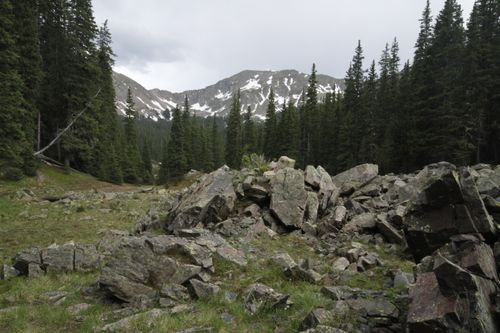
SWAP Habitat
Rocky Mountain Subalpine-High Montane Conifer Forest
NVC Name
Rocky Mountain Subalpine-High Montane Conifer Forest (M020)
SWAP General Vegetation Type
ALPINE and MONTANE VEGETATION
Rocky Mountain Subalpine-High Montane Conifer Forest [M020] (also known as Spruce-Fir Forest) occurs at the highest elevations (3,250-3,670 m (10,660-12,040 ft)) of any forest in the Southern Rocky Mountains and Arizona/New Mexico Mountains ecoregions, as well as isolated locations of the Madrean Archipelago ecoregion. It is mostly comprised of evergreen conifers with some broad-leaved, cold-deciduous trees. Canopies range from nearly closed-canopy forests to very open or patchy short-statured woodlands found in clumps or ribbons with intervening grasslands or shrublands. Characteristic trees include subalpine fir, Engelmann spruce, and quaking aspen. The shrub layer, when present, may be represented by tall or short cold-deciduous or evergreen shrubs such as fivepetal cliffbush (Jamesia americana), kinnikinnik (Arctostaphylos uva ursi), and whortleberry (Vaccinium myrtillus). Herbaceous cover can range from nearly absent under closed-canopy conditions to luxuriant and diverse on more open and moist sites. Representative species include dryspike sedge (Carex siccata), sprucefir fleabane (Erigeron eximius), starry false lily of the valley (Maianthemum stellatum), sickletop lousewort (Pedicularis racemosa), and Fendler’s meadow-rue (Thalictrum fendleri).
Locations of this habitat may be driven by interactions among several factors including snow deposition, desiccating winds, soil and substrate characteristics, precipitation, temperature, latitude, elevation, and aspect. This habitat can be found on gentle to very steep mountain slopes, high elevation ridgetops and upper slopes, shoulder slopes, cirque headwalls, plateau-like surfaces, basins, toeslopes, and alluvial stream terraces. At the highest elevations, trees can be weakened or damaged from blowing snow and ice-crystals as well as severe cold. This habitat is subject to stand-replacing disturbances such as avalanche, crown fire, insect outbreaks, disease, and occasional windthrow. Fire regimes are generally mixed severity or stand-replacing with long return intervals (150 to 500 years). Insect outbreaks are more frequent, every 30-50 years in some types, and can alter both the structure and composition of stands.
